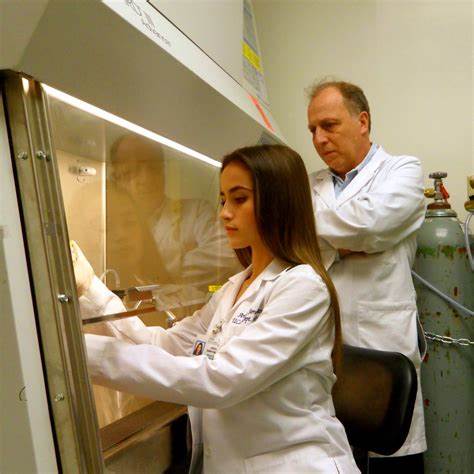Stem Cells
Stem Cells
2016 Oct
1. Live fluorescent RNA-based detection of pluripotency gene expression in embryonic and induced pluripotent stem cells of different species. Stem Cells. 2015 Feb;33(2):392-402.
3. Breakdown of Epithelial Barrier Integrity and Overdrive Activation of Alveolar Epithelial Cells in the Pathogenesis of Acute Respiratory Distress Syndrome and Lung Fibrosis. Biomed Res Int. 2015;2015:573210.
5. Expression of genes related to germ cell lineage and pluripotency in single cells and colonies of human adult germ stem cells. Stem Cells Int. 2016;2016:8582526.
7. Cartilage repair by human umbilical cord blood-derived mesenchymal stem cells with different hydrogels in a rat model. J Orthop Res. 2015 Nov;33(11):1580-6.
9. Expanded Hematopoietic Progenitor Cells Reselected for High Aldehyde Dehydrogenase Activity Demonstrate Islet Regenerative Functions. Stem Cells. 2016 Apr;34(4):873-87.
2. SETD7 Regulates the Differentiation of Human Embryonic Stem Cells. PLoS One. 2016 Feb 18;11(2):e0149502.
4. Murine Embryonic Stem Cell Plasticity Is Regulated through Klf5 and Maintained by Metalloproteinase MMP1 and Hypoxia. PLoS One. 2016 Jan 5;11(1):e0146281.
6. Highly efficient mesenchymal stem cell proliferation on poly-ε-caprolactone nanofibers with embedded magnetic nanoparticles. Int J Nanomedicine. 2015 Dec 7;10:7307-17
8. Evaluation of the effect of adipose tissue-derived stem cells on the quality of bone healing around implants. Connect Tissue Res. 2016;57(1):10-9.

Bill Skarnes, Ph.D. Professor and Director, Cellular Engineering The Jackson Laboratory Krishanu Saha, Ph.D. Associate Professor of Biomedical Engineering University of Wisconsin-Madison Rasmus Bak, Ph.D. Associate Professor Aarhus University, Denmark
2015 Oct
1. Destabilization of pluripotency in the absence of Mad2l2. Cell Cycle. 2015;14(10):1596-610.
3. Direct conversion of human fibroblasts into neuronal restricted progenitors. J Biol Chem. 2014 Feb 21;289(8):5250-60.
5. Sphingosine-1-phosphate inhibits differentiation of C3H10T1/2 cells into adipocyte. Mol Cell Biochem. 2015 Mar;401(1-2):39-47.
7. Prolonged proteasome inhibition cyclically upregulates Oct3/4 and Nanog gene expression, but reduces induced pluripotent stem cell colony formation. Cell Reprogram. 2015 Apr;17(2):95-105.
9. Uterine-Derived Stem Cells Reconstitute the Bone Marrow of Irradiated Mice. Stem Cells Dev. 2015 Apr 15;24(8):938-47.
12. Beneficial Effect of Human Induced Pluripotent Stem Cell-Derived Neural Precursors in Spinal Cord Injury Repair. Cell Transplant. 2015;24(9):1781-97.
2. Optimization of Mesenchymal Stem Cells (MSCs) Delivery Dose and Route in Mice with Acute Liver Injury by Bioluminescence Imaging. Mol Imaging Biol. 2015 Apr;17(2):185-94.
4. New adipose tissue formation by human adipose-derived stem cells with hyaluronic acid gel in immunodeficient mice. Int J Med Sci. 2015 Jan 8;12(2):154-62.
6. Cellular behaviour of hepatocyte-like cells from nude mouse bone marrow-derived mesenchymal stem cells on galactosylated poly(D,L-lactic-co-glycolic acid). J Tissue Eng Regen Med. 2015 Jul;9(7):819-25.
8. A Nanoparticle-based Sensor Platform for Cell Tracking and Status/Function Assessment. Scientific Reports. 2015 Oct 6;5:14768.
10. Three-Dimensional Environment Sustains Hematopoietic Stem Cell Differentiation into Platelet-Producing Megakaryocytes. PLoS One. 2015 Aug 27;10(8):e0136652.
11. Fibroblast-Negative CD34-Negative Cells from Human Adipose Tissue Contain Mesodermal Precursors for Endothelial and Mesenchymal Cells. Stem Cells Dev. 2015 Oct 1;24(19):2280-96.
Archives
2015 July
2015 May
2013 November
2013 September
2013 July
BREAKING NEWS: Editors’ Picks
- Functional human liver cells grown in the lab. Nature Biotechnology, November 26, 2015
This groundbreaking development could help advance a variety of liver-related research and applications, from studying drug toxicity to creating bio-artificial liver support for patients awaiting transplantations. - Deep imaging of bone marrow shows non-dividing stem cells are mainly perisinusoidal. Nature, September 23, 2015;
The findings, the first to use a tissue-clearing technique in bones, provide a significant advance toward understanding the microenvironment in which stem cells reside within the bone marrow. - New transitional stem cells discovered. PNAS, April 16, 2015
Embryonic stem cells exist in a number of different transitional states, which likely resemble those encountered in the early stages of embryos.
- Stem cell disease model clarifies bone cancer trigger. Cell, April 9, 2015.
revealed for the first time how p53, may instead drive bone cancer when genetic changes cause too much of it to be made in the wrong place. - New gene involved in blood-forming stem cells. JCI, April 13, 2015.
A gene (Ash1l) critical to controlling the body’s ability to create blood cells and immune cells from blood-forming stem cells — known as hematopoietic stem cells — has been discovered by researchers. The discovery also opens new lines of inquiry about the gene’s potential role in cancers. - Plasticity of Hopx type I alveolar cells to regenerate type II cells in the lung. Nature Communications, April 13, 2015
The lung cells can regenerate from one another as needed to repair missing tissue, suggesting that there is much more flexibility in the system than we have previously appreciated. - Stem cells born out of indecision. Cell Reports. December 18, 2014
Researchers at the University of Copenhagen specifically found that inhibiting or blocking stem cells ability to make a specific decision, leads to better cell growth and could lead to defined ways to differentiate stem cells. This research is the first comprehensive analysis of a pathway important for stem and cancer cell decisions known as Erk. As a result this work could contain clues to cancer treatment as well as helping to establish a platform to make stem cell treatments for gut related disorders like the pancreas or the liver. - Lung regeneration mechanism discovered. Nature, November 12, 2014.
The role of certain lung stem cells in regenerating lungs damaged by disease. Their work sheds light on the inner workings of the still-emerging concept of lung regeneration and points to potential therapeutic strategies that harness these lung stem cells. - Path to the Clinic: Assessment of iPSC-Based Cell Therapies In Vivo in a Nonhuman Primate Model. Cell Reports, May 15, 2014.
it is possible to make new bone from stem-cell-like induced pluripotent stem cells (iPSCs) made from an individual animal’s own skin cells. The study in monkeys also shows that there is some risk that those iPSCs could seed tumors, but that unfortunate outcome appears to be less likely than studies in immune-compromised mice would suggest.
 Euro
Euro
 US Dollar
US Dollar
